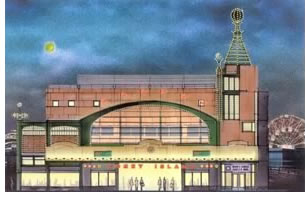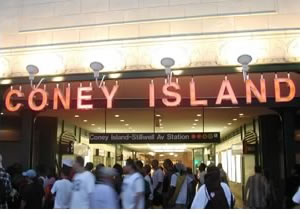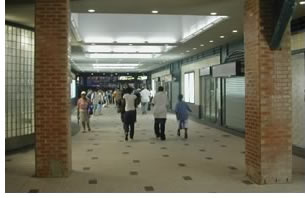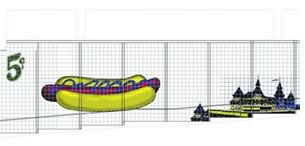

08/2005
di Domenico + Partners new transit building plays on amusement’s past
 Coney
Island’s
new subway portal building brings renewed life to its surrounding entertainment
community, reinvigorating a playful architectural
heritage. Designed by New York City-based di Domenico + Partners, the
Stillwell Avenue Portal Building links the NYC Transit Coney Island Terminal
and Surf Avenue, a major thoroughfare in the world-famous beach and amusement
neighborhood. Replacing an outdated, one-story arcade and transit connector,
the new 33,000-square-foot building will bring one story of vibrant year-round
and seasonal retail and restaurants, two stories devoted to housing the
New York Police Department’s District 34 offices, and additional
office space for affiliated transit groups such as signal maintainers.
Coney
Island’s
new subway portal building brings renewed life to its surrounding entertainment
community, reinvigorating a playful architectural
heritage. Designed by New York City-based di Domenico + Partners, the
Stillwell Avenue Portal Building links the NYC Transit Coney Island Terminal
and Surf Avenue, a major thoroughfare in the world-famous beach and amusement
neighborhood. Replacing an outdated, one-story arcade and transit connector,
the new 33,000-square-foot building will bring one story of vibrant year-round
and seasonal retail and restaurants, two stories devoted to housing the
New York Police Department’s District 34 offices, and additional
office space for affiliated transit groups such as signal maintainers.
 That Coney Island mystique
That Coney Island mystique
Referencing Coney Island’s colorful past as an amusement and beach
community, the building playfully reinterprets the “Playland” style.
Constructed of sand-colored panels that suggest brick, the building looks
like a large sandcastle, complete with flags and a tower. “What
was previously in this location was just a portal to the subway,” says
di Domenico partner Andrew Berger, AIA. “Our intent was to bring
back the flavor, fun, and mystique of Luna Park as an architectural folly
at the heyday of the amusement era. The new Portal Building makes the
Coney Island subway stop an important transportation location as well
as a fun place to arrive at the beach.”
 Echoing the historic Luna Park’s lighted spires and minarets,
the Portal Building’s façade and tower is strung with low-wattage
LED lights, making it a prominent landmark. Its southern entrance also
honors the community’s architectural roots through incorporation
of a terra cotta parapet preserved from the original building. According
to the architect, the parapet was painstakingly removed, archived, restored,
and replaced because they felt that it was important to preserve its
history of place. The parapet, which runs nearly the full length of the
building, has been recommended for listing on the National Register of
Historic Places. Says Berger, the parapet “defines the Surf Avenue
façade of the building and establishes a portal to the interior
retail spaces and the transit connections beyond.”
Echoing the historic Luna Park’s lighted spires and minarets,
the Portal Building’s façade and tower is strung with low-wattage
LED lights, making it a prominent landmark. Its southern entrance also
honors the community’s architectural roots through incorporation
of a terra cotta parapet preserved from the original building. According
to the architect, the parapet was painstakingly removed, archived, restored,
and replaced because they felt that it was important to preserve its
history of place. The parapet, which runs nearly the full length of the
building, has been recommended for listing on the National Register of
Historic Places. Says Berger, the parapet “defines the Surf Avenue
façade of the building and establishes a portal to the interior
retail spaces and the transit connections beyond.”
 Making public transit fun
Making public transit fun
Rising above the parapet is a large steel-and-glass clerestory that references
the frame of the subway terminal to the north and allows light to infuse
the space below, reducing dependence on artificial lighting. Commuters
and tourists are greeted by sun-drenched, skylighted spaces and local
artist Robert Wilson’s 300-foot-long translucent installation
entitled, “My Coney Island Baby.”
Composed of silk-screened archival images of popular Coney Island icons—a hot dog, the Cyclone roller coaster, the Parachute Jump, and the Wonder Wheel Ferris wheel—that are sandwiched between glass bricks, the 17-foot-high curvilinear installation runs along the eastern side of the Portal Building. The work was commissioned by the MTA’s Arts for Transit program, which strives to make public transportation more inviting and pleasurable.
 Enhanced transportation and security
Enhanced transportation and security
Berger notes that, given the heightened awareness and sensitivity to
security concerns in recent years, the Portal Building features many
state-of-the-art security technologies, including obvious measures
and deterrents such as CCTV, abundant well-lighted spaces, and the
visually prominent NYPD storefront.
 The architect also points out that that the Portal Building is part
of a major transportation plan to improve the overall quality of service
and provide new services and vigor to this beach community. Discussing
the need to keep the building’s retail spaces vibrant and lively
during off-peak months, he says that, “Hundreds of thousands of
people move through this space in the summer. It was important that the
retail and services in the building provide a dynamic and positive energy
throughout the year.” Working with the MTA Real Estate group, di
Domenico decided to combine franchise retail and restaurants with the “seasonal,
Mom & Pop arcade operations.” The seasonal retail will include
the traditional beach-town mix of candy shops, newspaper stands, souvenirs,
and beachwear—“a piece of the boardwalk within the interior
street,” says Berger. The franchise retail will anchor the exterior
corridor and provide interest from the main thoroughfare.
The architect also points out that that the Portal Building is part
of a major transportation plan to improve the overall quality of service
and provide new services and vigor to this beach community. Discussing
the need to keep the building’s retail spaces vibrant and lively
during off-peak months, he says that, “Hundreds of thousands of
people move through this space in the summer. It was important that the
retail and services in the building provide a dynamic and positive energy
throughout the year.” Working with the MTA Real Estate group, di
Domenico decided to combine franchise retail and restaurants with the “seasonal,
Mom & Pop arcade operations.” The seasonal retail will include
the traditional beach-town mix of candy shops, newspaper stands, souvenirs,
and beachwear—“a piece of the boardwalk within the interior
street,” says Berger. The franchise retail will anchor the exterior
corridor and provide interest from the main thoroughfare.
Copyright 2005 The American Institute of Architects.
All rights reserved. Home Page ![]()
![]()
